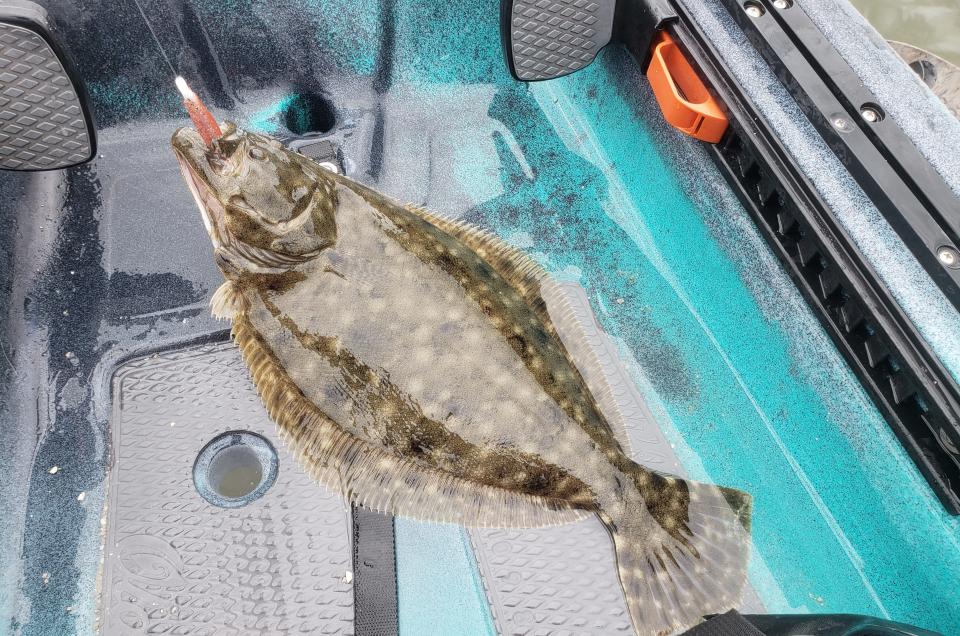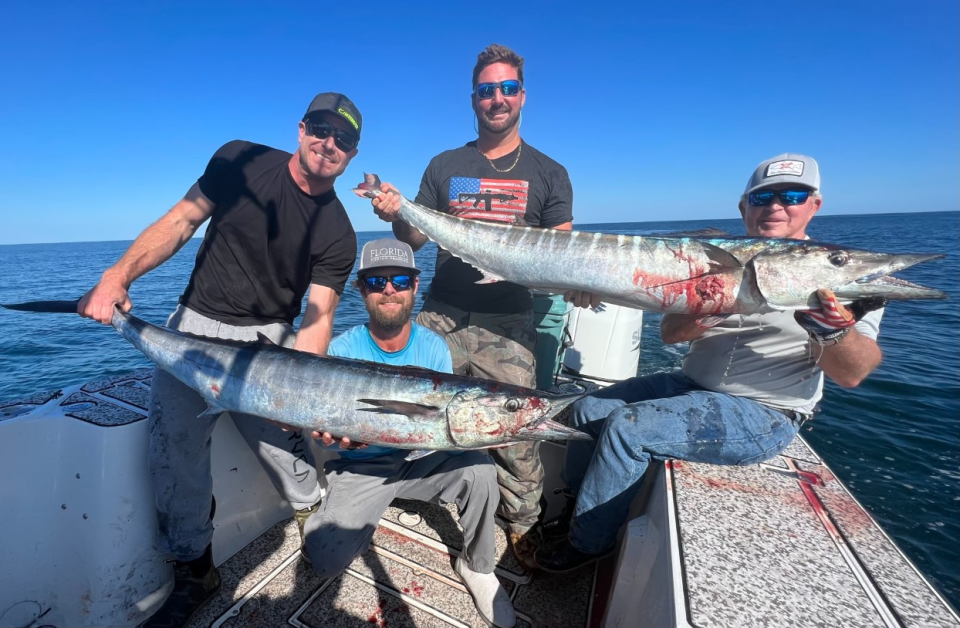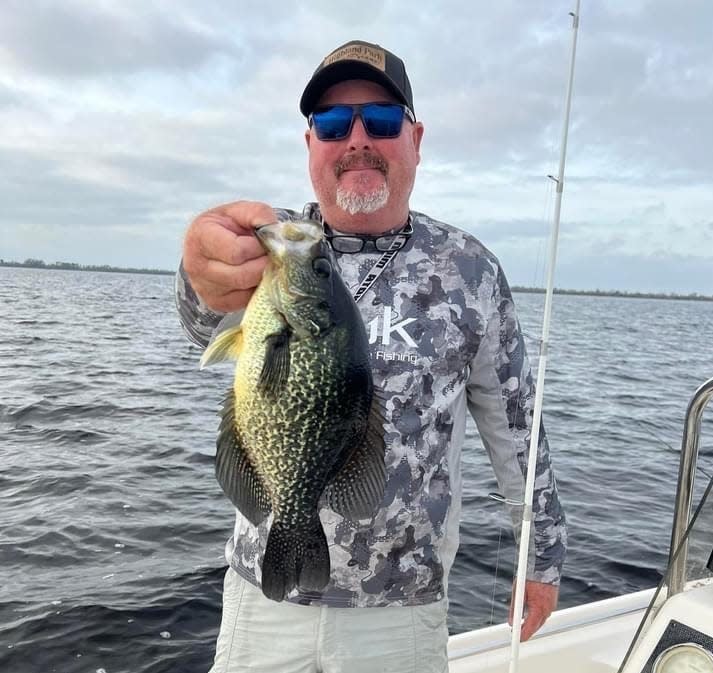Flounder come off the sidelines; wanna know how to hook an amazing dish? | FISHING REPORT
And you thought the PGA and NASCAR had short off-seasons!
Flounder’s time-out lasted all of 47 days, from Oct. 15 to Nov. 30, a catch-and-release period started two years ago by the state to help the population of these flat fish with tall reputations.
Why the love for such an odd-looking creature? Search for flounder recipes and you’ll get a great variety of amazing dishes — even a few that don’t include breading. Go figure.
But while that’s enough for many, there’s another reason anglers like to fish for flounder: Because, by and large, you have to fish for flounder.
While many of our Florida favorites will move from here to there in search of the next morsel, like curious tasters at a gathering of food trucks, the flounder is a seat-at-the-table kind of guy.

Instead of drive-thru, he awaits the drive-by. Just sprawls on the river bottom like a doormat (hence the bigger flounders’ popular nickname), those two eyeballs looking straight up, waiting on you to bounce or float something irresistible above his snout.
And irresistible can be anything from a minnow or shrimp to “America’s artificial” — a soft plastic snuggled over a light jig head.
CHRISTMAS SHOPPING: Buying for your favorite angler? You might want to reconsider
FISHBITES: The idea for the popular bait began with young Billy Carr in New Smyrna Beach
“Just slowly bounce it across the bottom, under docks, along seawalls and oyster beds,” suggests Gene Lytwyn from behind the counter at The Fishin’ Hole in Daytona Beach.
No boat? No problem, according to Gene.
“Walk the length of a dock or seawall, drop a jig to the bottom and just bounce it up and down as you walk slowly,” he says. “This can also be done with live bait on a jig head.”
Others on our weekly “committee” also list flounder as a favorite, and these days for a good reason.
“The flounder are very plentiful in the river right now,” says Capt. Jeff Patterson. “I’ve been seeing tons of flounder spots.”
Can’t say I’ve looked close enough or even tried to find this, but it’s said, at low tide, along sandbars you can find outlines of flounder imprinted in the sand, indicating their higher-tide seat at the table, as well as tracks. Go back to those spots when the water returns, obviously.
Stingrays are a nasty by-product of flounder fishing, so if you’re wade-fishing a sandbar, shuffle those feet.
Back to our flounder committee, where Capt. Mike Vickers has a soup-to-nuts game plan for those looking to get to the bottom of (and for) flounder.
![Flounder française over Parmesan risotto with a veggie medley. [Photo Courtesy Eric Kozen]](https://s.yimg.com/ny/api/res/1.2/MYnKZFuW_sdtfdgxRRpuoQ--/YXBwaWQ9aGlnaGxhbmRlcjt3PTk2MDtoPTcwNw--/https://media.zenfs.com/en/daytona-beach-news-journal/7ceece1d0f91fca6dbfaed09e33a8af6)
His gear: Light, lighter and damn near lightest — 6- or 7-foot light rod with 4-to-8-pound test (“moss green” mono is his preferred).
“I like these rods for their sensitivity,” he says. “I can feel and see every tap and bump.”
Also, a small to medium circle hook with a small split-shot 4-to-8 inches up the line, to help get the bait down to the fish.
Live bait: Mud minnows are best, but shrimp and small mullet are also good.
Artificials: A variety of combinations on a jig head weighing in at a 16th or eighth of an ounce.
Geography: Pretty much similar to a large number of targeted species.
“Creek mouths, creek holes and oyster bars that have water moving in and out from multiple directions, and I never overlook rocks and grass lines.”
Presentation: “I break with tradition in presentation,” he says. “I fish my baits faster than most, and when using live baits I like my bait just off the bottom. Doing this, I’m fishing both active and inactive fish.”
So there you have it, so now have at it. Keep in mind, you might consider the flounder lazy due to its habit of lounging and awaiting food to pass by, but once hooked, it comes to life rather quickly — yet another reason for its popularity.
Reminder: A legal flounder must be 14 inches, minimum, and you daily bag limit is five.
“What about gigging for flounder?” you might ask. Another story for another day. Or another night, specifically.
Halifax/Indian River: Sheepshead are getting busy
The long Granada Pier behind Ike Leary’s Ormond Beach bait shop has seen an uptick in activity.
“Plenty of black drum and sheepshead off the pier,” Ike says. “Lots of snook popping, too.”
Capt. Jeff Patterson (Pole Dancer charter) checks back in to say his phone is starting to ring a little more often these days, after some slow weeks due to Ian and Nicole. His best results in the river have been amongst the mangroves on an outgoing tide — reds, snook, mangrove snapper and “a bunch of jacks, ladies and blues,” he says.
“I’ve been free-lining them or using a split-shot at times,” he says. “Black drum are still biting around the bridges and the sheepshead bite has been really productive.”
Capt. Barry Englehardt fishes the Tomoka River and Basin a lot and says the sheepshead are also up that way, along with mangrove snapper and trout. He ventured south to Ponce Inlet and says he used croakers to catch some bull reds.
Another reminder: Trout are catch-and-release until Jan. 1. Redfish are catch-and-release south of New Smyrna Beach's south causeway; limit of one per day north of that causeway, with the tight slot of 28-32 inches.

Surf: Awaiting easy access, and pompano
Still awaiting a rush of pompano to pass from north to south. Hard to get frontline reports these days because beach access is still an issue for most.
Dustin Smith (NSB Shark Hunters) has been spending some down time on the Canaveral Seashore, catching some small pompano and, of course, catfish.
Flagler County: Sheepshead at the inlet, a few pompano near bridge
Capt. Mike Vickers (Hammock Beach Bait & Tackle) says this week is similar to last week, though the sheepshead population has grown, especially around Matanzas Inlet.
He’s gotten reports of “a few” pompano being caught off the east side of the inlet bridge.
St. Johns: Ian and Nicole's imprints still here, but easing; meanwhile, specks are hot
A little bit of good news in Astor.
Just a bit.
“The water has started going out pretty good,” says Kerry McPherson, who’s up to here in mud at his South Moon Fish Camp. “I’d say about an inch a day, anyhow. Drying out a little bit. Gotta clean up all the mud now.”
He’s aiming for re-opening around the first of the year, barring the unforeseen.
“Driveways, parking areas, the entrance lane . . . just a nasty mess,” he said during a break from the tractor.
Continued better news to the south in DeLand, where speck season has folks launching from the ramp at Highland Park Fish Camp and returning to the filet table.
“If you like to open-water troll, you can't go wrong right now,” says Capt. Bryn Adams. “Fishermen are bringing in big numbers from Lake Woodruff. Artificial jigs are the best bait but a minnow will work, too.”

Best bet for bass continues to be closer to the springs, due to lingering tannic acid throughout the St. Johns.
“But the good news is, the water is going down in record time,” Capt. Bryn says.
Also: "Merry Fishmas"
It’s almost “Merry Fishmas” time for the Halifax Sport Fishing Club, which will host its annual kids fishing outing Dec. 11 at the club.
Kids age 5-15 will visit five learning stations to learn everything from local regulations to knot-tying. Better yet, it’s free.
More info: HSFC.com.
Hook, Line & Clicker: Send us your fish pics
We want to see your most recent catch. Email your fish photos to ken.willis@news-jrnl.com.
Please include first and last name of angler(s), as well as type of fish (we're occasionally stumped). All are included with our online fishing report, and some occasionally make the print edition.
Do I need a fishing license?
You can find all the license info, including exemptions, on Florida's Fish and Wildlife Commission website: MyFWC.com. But the basics are:
No: If you're 65 or older, 15 or younger, you don't need a license.
No: If you're fishing with a licensed guide or charter boat, both of which purchase commercial licenses that cover their customers.
Yes: Most everyone else, including visitors from other states.
Yes: Even if you're a shore-based angler (shoreline, dock, pier, bridge, etc.). However: The shore-based license is free . . . But: You still need to register for that free license.
Where do I get a license, and what does it cost?
Many bait shops sell licenses, as do the bigger retailers (Bass, Dick's, Walmart, etc.).
Florida's FWC uses a third-party site for buying or renewing fishing licenses: GoOutdoorsFlorida.com.
The cost: $17 for an annual license.
Don't forget: Whether you're fishing fresh or saltwater, you need the specific license. Freshwater and saltwater licenses are both $17 annually.
I'm here on vacation, do I need a fishing license?
Yes you do, and they're also available at GoOutdoorsFlorida.com or certain bait shops and big retailers.
Cost: $17 for three days, $30 for seven days, $47 for a year.
Also: Non-residents need to purchase that license even if they're just fishing from shoreline or shore-based structures. (Florida residents need that license, too, but they're free.)
This article originally appeared on The Daytona Beach News-Journal: Flounder? I hardly know her! Here's how to hook up with ol' flatty

